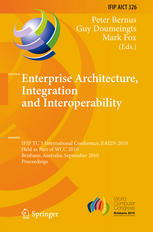

Most ebook files are in PDF format, so you can easily read them using various software such as Foxit Reader or directly on the Google Chrome browser.
Some ebook files are released by publishers in other formats such as .awz, .mobi, .epub, .fb2, etc. You may need to install specific software to read these formats on mobile/PC, such as Calibre.
Please read the tutorial at this link: https://ebookbell.com/faq
We offer FREE conversion to the popular formats you request; however, this may take some time. Therefore, right after payment, please email us, and we will try to provide the service as quickly as possible.
For some exceptional file formats or broken links (if any), please refrain from opening any disputes. Instead, email us first, and we will try to assist within a maximum of 6 hours.
EbookBell Team

4.1
10 reviewsEnterprise Architecture, Integration, and Interoperability and the Networked enterprise have become the theme of many conferences in the past few years. These conferences were organised by IFIP TC5 with the support of its two working groups: WG 5. 12 (Architectures for Enterprise Integration) and WG 5. 8 (Enterprise Interoperability), both concerned with aspects of the topic: how is it possible to architect and implement businesses that are flexible and able to change, to interact, and use one another’s s- vices in a dynamic manner for the purpose of (joint) value creation. The original qu- tion of enterprise integration in the 1980s was: how can we achieve and integrate - formation and material flow in the enterprise? Various methods and reference models were developed or proposed – ranging from tightly integrated monolithic system - chitectures, through cell-based manufacturing to on-demand interconnection of bu- nesses to form virtual enterprises in response to market opportunities. Two camps have emerged in the endeavour to achieve the same goal, namely, to achieve interoperability between businesses (whereupon interoperability is the ability to exchange information in order to use one another’s services or to jointly implement a service). One school of researchers addresses the technical aspects of creating dynamic (and static) interconnections between disparate businesses (or parts thereof).